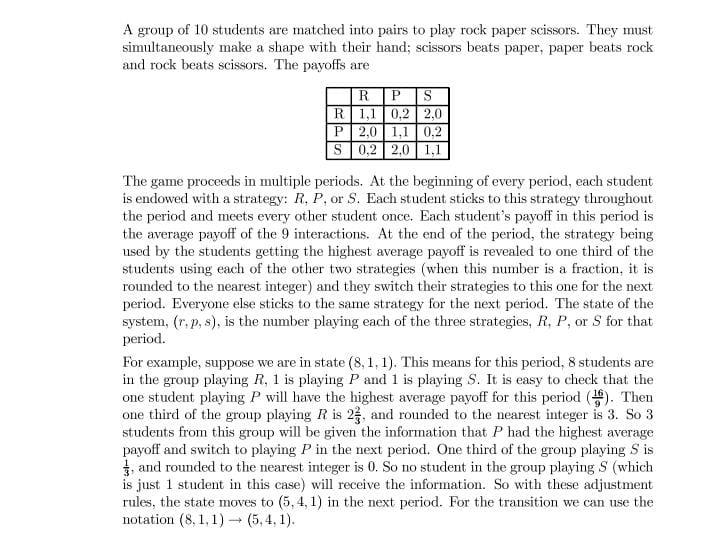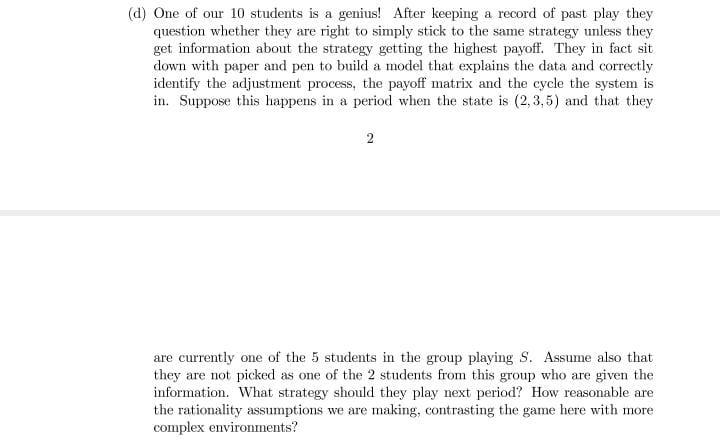Please solve this with in 1 hour


A group of 10 students are matched into pairs to play rock paper scissors. They must simultaneously make a shape with their hand; scissors beats paper, paper beats rock and rock beats scissors. The payoffs are The game proceeds in multiple periods. At the beginning of every period, each student is endowed with a strategy: R,P, or S. Each student sticks to this strategy throughout the period and meets every other student once. Each student's payoff in this period is the average payoff of the 9 interactions. At the end of the period, the strategy being used by the students getting the highest average payoff is revealed to one third of the students using each of the other two strategies (when this number is a fraction, it is rounded to the nearest integer) and they switch their strategies to this one for the next period. Everyone else sticks to the same strategy for the next period. The state of the system, (r,p,s), is the number playing each of the three strategies, R,P, or S for that period. For example, suppose we are in state (8,1,1). This means for this period, 8 students are in the group playing R,1 is playing P and 1 is playing S. It is easy to check that the one student playing P will have the highest average payoff for this period (916). Then one third of the group playing R is 232, and rounded to the nearest integer is 3 . So 3 students from this group will be given the information that P had the highest average payoff and switch to playing P in the next period. One third of the group playing S is 31, and rounded to the nearest integer is 0 . So no student in the group playing S (which is just 1 student in this case) will receive the information. So with these adjustment rules, the state moves to (5,4,1) in the next period. For the transition we can use the notation (8,1,1)(5,4,1). d) One of our 10 students is a genius! After keeping a record of past play they question whether they are right to simply stick to the same strategy unless they get information about the strategy getting the highest payoff. They in fact sit down with paper and pen to build a model that explains the data and correctly identify the adjustment process, the payoff matrix and the cycle the system is in. Suppose this happens in a period when the state is (2,3,5) and that they 2 are currently one of the 5 students in the group playing S. Assume also that they are not picked as one of the 2 students from this group who are given the information. What strategy should they play next period? How reasonable are the rationality assumptions we are making, contrasting the game here with more complex environments? A group of 10 students are matched into pairs to play rock paper scissors. They must simultaneously make a shape with their hand; scissors beats paper, paper beats rock and rock beats scissors. The payoffs are The game proceeds in multiple periods. At the beginning of every period, each student is endowed with a strategy: R,P, or S. Each student sticks to this strategy throughout the period and meets every other student once. Each student's payoff in this period is the average payoff of the 9 interactions. At the end of the period, the strategy being used by the students getting the highest average payoff is revealed to one third of the students using each of the other two strategies (when this number is a fraction, it is rounded to the nearest integer) and they switch their strategies to this one for the next period. Everyone else sticks to the same strategy for the next period. The state of the system, (r,p,s), is the number playing each of the three strategies, R,P, or S for that period. For example, suppose we are in state (8,1,1). This means for this period, 8 students are in the group playing R,1 is playing P and 1 is playing S. It is easy to check that the one student playing P will have the highest average payoff for this period (916). Then one third of the group playing R is 232, and rounded to the nearest integer is 3 . So 3 students from this group will be given the information that P had the highest average payoff and switch to playing P in the next period. One third of the group playing S is 31, and rounded to the nearest integer is 0 . So no student in the group playing S (which is just 1 student in this case) will receive the information. So with these adjustment rules, the state moves to (5,4,1) in the next period. For the transition we can use the notation (8,1,1)(5,4,1). d) One of our 10 students is a genius! After keeping a record of past play they question whether they are right to simply stick to the same strategy unless they get information about the strategy getting the highest payoff. They in fact sit down with paper and pen to build a model that explains the data and correctly identify the adjustment process, the payoff matrix and the cycle the system is in. Suppose this happens in a period when the state is (2,3,5) and that they 2 are currently one of the 5 students in the group playing S. Assume also that they are not picked as one of the 2 students from this group who are given the information. What strategy should they play next period? How reasonable are the rationality assumptions we are making, contrasting the game here with more complex environments








